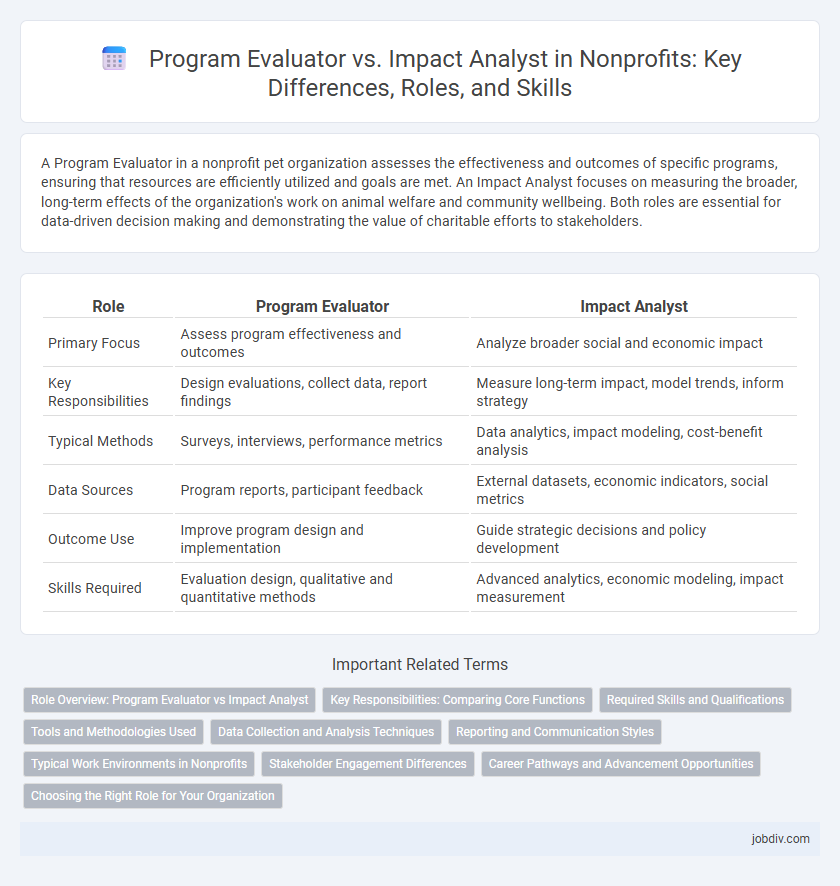A Program Evaluator in a nonprofit pet organization assesses the effectiveness and outcomes of specific programs, ensuring that resources are efficiently utilized and goals are met. An Impact Analyst focuses on measuring the broader, long-term effects of the organization's work on animal welfare and community wellbeing. Both roles are essential for data-driven decision making and demonstrating the value of charitable efforts to stakeholders.
Table of Comparison
| Role | Program Evaluator | Impact Analyst |
|---|---|---|
| Primary Focus | Assess program effectiveness and outcomes | Analyze broader social and economic impact |
| Key Responsibilities | Design evaluations, collect data, report findings | Measure long-term impact, model trends, inform strategy |
| Typical Methods | Surveys, interviews, performance metrics | Data analytics, impact modeling, cost-benefit analysis |
| Data Sources | Program reports, participant feedback | External datasets, economic indicators, social metrics |
| Outcome Use | Improve program design and implementation | Guide strategic decisions and policy development |
| Skills Required | Evaluation design, qualitative and quantitative methods | Advanced analytics, economic modeling, impact measurement |
Role Overview: Program Evaluator vs Impact Analyst
Program Evaluators systematically assess the effectiveness and efficiency of nonprofit programs through data collection, analysis, and stakeholder feedback, ensuring alignment with organizational goals. Impact Analysts concentrate on measuring and interpreting the long-term social, economic, or environmental outcomes of initiatives by using advanced metrics and impact assessment frameworks. Both roles are crucial for evidence-based decision-making, enhancing program quality, and demonstrating value to funders and communities.
Key Responsibilities: Comparing Core Functions
Program Evaluators assess nonprofit initiatives by measuring effectiveness, efficiency, and adherence to objectives through qualitative and quantitative data collection. Impact Analysts focus on analyzing long-term outcomes and social impact using advanced statistical models and data visualization tools to guide strategic decision-making. Both roles collaborate to enhance program performance, with evaluators emphasizing process improvements and analysts prioritizing evidence-based impact reporting.
Required Skills and Qualifications
Program evaluators require strong expertise in qualitative and quantitative research methods, proficiency in data collection tools, and the ability to design evaluation frameworks aligned with nonprofit goals. Impact analysts must have advanced skills in statistical analysis, data visualization software, and experience with outcome measurement to assess program effectiveness quantitatively. Both roles demand critical thinking, excellent communication skills for reporting findings, and familiarity with nonprofit sector dynamics.
Tools and Methodologies Used
Program evaluators employ qualitative and quantitative tools such as logic models, surveys, interviews, and focus groups to assess program effectiveness, utilizing methodologies like formative and summative evaluations. Impact analysts leverage advanced statistical software, data visualization tools, and econometric models, including difference-in-differences and propensity score matching, to measure and quantify social impact. Both roles integrate mixed-method approaches to triangulate data and provide comprehensive insights on nonprofit program outcomes.
Data Collection and Analysis Techniques
Program evaluators utilize qualitative and quantitative data collection methods such as surveys, interviews, and focus groups to assess nonprofit program effectiveness. Impact analysts emphasize advanced statistical analysis and data modeling techniques, including regression analysis and predictive analytics, to measure long-term outcomes and social impact. Both roles prioritize accurate data management but differ in depth of analytical tools applied to derive actionable insights for nonprofit decision-making.
Reporting and Communication Styles
Program Evaluators prioritize comprehensive data collection and structured reporting to assess the effectiveness of nonprofit initiatives, ensuring clarity for stakeholders and funders. Impact Analysts emphasize real-time data visualization and storytelling techniques to communicate outcomes and influence strategic decisions quickly. Both roles require tailoring reports to diverse audiences, but Program Evaluators focus on detailed accountability while Impact Analysts highlight actionable insights for ongoing improvement.
Typical Work Environments in Nonprofits
Program Evaluators in nonprofits typically work within grant management offices, development departments, or evaluation teams, focusing on assessing program effectiveness and compliance with funding requirements. Impact Analysts often operate in data and research divisions or strategic planning units, concentrating on measuring long-term social outcomes and informing organizational decisions. Both roles may collaborate across field offices and community partner sites to collect qualitative and quantitative data for comprehensive nonprofit impact assessment.
Stakeholder Engagement Differences
Program Evaluators primarily engage stakeholders through comprehensive feedback loops to assess program effectiveness and inform strategic adjustments. Impact Analysts focus on quantifying long-term outcomes and communicating these results to stakeholders to demonstrate value and inform funding decisions. Both roles require tailored communication strategies but differ in emphasis, with Program Evaluators prioritizing qualitative insights and Impact Analysts emphasizing data-driven impact measurement.
Career Pathways and Advancement Opportunities
Program Evaluators assess the effectiveness and efficiency of nonprofit initiatives, using data collection and analysis to inform strategic decision-making and improve program outcomes. Impact Analysts specialize in measuring long-term social change by analyzing qualitative and quantitative data to demonstrate organizational value and inform stakeholder reporting. Career pathways for Program Evaluators often lead to roles in program management or nonprofit leadership, while Impact Analysts typically advance toward strategic planning, grant management, or executive impact officer positions.
Choosing the Right Role for Your Organization
Program evaluators assess the effectiveness and efficiency of nonprofit initiatives by collecting and analyzing qualitative and quantitative data to improve program design and implementation. Impact analysts focus on measuring the long-term social and economic outcomes of nonprofit activities using advanced metrics and statistical models to demonstrate value to stakeholders. Selecting the right role depends on whether your organization prioritizes internal program improvement or external impact measurement and reporting.
Program Evaluator vs Impact Analyst Infographic

 jobdiv.com
jobdiv.com